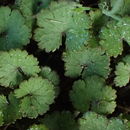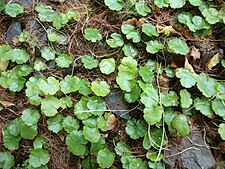pt-BR
nomes no trilho de navegação


Hydrocotyle sibthorpioides is a small plant native to southeastern Asia. It is also referred to as lawn marshpennywort.[2] It is a dicot, traditionally placed in the family Apiaceae, but more recently suggested to belong in the Araliaceae.[3] It grows in abundance when the conditions are right. Hydrocotyle sibthorpioides originated in southeastern Asia, but is slowly spreading in the United States, along with other places around the world. It can grow in a wide variety of habitats. It has been used for medicinal purposes in Asia and is also common in the aquarium trade.
The leaf width ranges from 0.5 to 2 cm. The plant has a moderate growth rate[4] and produces small flowers. The flowers are a faint yellow with a hint of purple.[5] Flower clusters are simple and flat topped or rounded. There are inconspicuous involucral bracts at the base of each flower and indistinct sepals. The leaves are simple, with a small leafy outgrowth at the base, and kidney-shaped to round. Leaf edges are scalloped. The leaves are broad and alternate. The peltate leaves are often described as egg-shaped; all of the leaves are hairless and they often have five to seven shallow lobes around the edge. Fruits are flat and break in half when the plant reaches maturity. Once the fruit has broken open, there is one seed on each side.[6] The fruits are elliptical to round with thin ridges and no oil tubes (vitta), which is characteristic in the fruit of umbelliferous plants.[7]
Hydrocotyle sibthorpioides is traditionally treated within the family Apiaceae,[8] although recent results place it in the Araliaceae.[3] A moleculary phylogeny shows H. sibthorpioides to be closely related to H. americana, H. bonariensis, H. bowlesioides, H. hirsute, and H. umbellata, among others.[8]
Hydrocoytle sibthorpioides is most common in southeastern Asia. Although it is native to Asia, there are parts of the United States where this plant thrives as an introduced species, particularly in the eastern US and some areas in California.[9] Recently, it has been reported to flourish in southeast Australia, where it occurs in Brisbane and Sydney, is native to Western Australia.[10] This species is able to grow in a wide variety of habitats, from dry areas to locations that are occasionally submerged. It can also be found between sidewalk cracks, and is increasingly occurring as a lawn weed.[11]
For the plant to reach its full growth it must have full sunlight.[9] It can tolerate temperatures between 10 and 30°C, but grows best when the temperature stays between 20 and 28°C. It has a soil pH preference of 5 to 7. Propagation of this plant is mostly by cuttings.[12]
The conservation status for H. sibthorpioides is of least concern; it continues to grow and spread throughout the United States along with other regions of the world such as Australia.[13]
Phytochemical investigations identified and isolated 50 phytoconstituents from the plant, of which asiaticoside and madecasoside were the chief constituents. Phytoconstituents isolated were camphene, genistein, hydrocosisaponin A-F, hydrocotyloside I-VII, isorhamnetin, l-sesamin, ocimene, phytol, quercetin, hyperoside, quercetin 3-(6-caffeoylgalactoside), stigmasterol, stigmasterol isomers, trans-β-farnesene, udosaponin B, α-humulene, α-pinene, β-caryophyllene, and β-pinene. Other compounds identified by HPLC analysis are 2-ethylacridine, 2-methyl-3-O-tolyl-6-hydroxy-4(3H)-quinazolinone, 3-(4-(hydroxymethyl)phenyl)-2-ethylquinazolin-4(3H)-one, demecolcine, 9,10,10-trimethyl-9,10-dihydroanthracene, rosmarinic acid, chlorogenic acid, catechin, epicatechin, quercetin, biochanin A, rutin, gallic acid, ferulic acid, caffeic acid, ascorbic acid, and α-tocopherol.[14]
Many tribes in the world use H. sibthorpioides to treat fever, edoema, dysentery, rheumatalgia, whooping cough, jaundice, throat discomfort, psoriasis, herpes zoster infection, hepatitis-B infection, calming pain, dysmenorrhoea, and carbunculosis.[15] In Assam, it is also employed as a hepatoprotective agent, a brain tonic, and a detoxifying agent.[16] Bengali villagers use the entire plant for bone fractures.[17] Extracts of this plant have been found to be free from toxicity up to a dose of 2000 mg/kg in rats.[18]
The phytoconstituents of H. sibthorpioides have shown a wide range of therapeutic utility, although pharmacological use is only justified if it has a satisfactory safety profile. There is no indication that the plant or its extracts have ever been tested in a clinical experiment. Following OECD standards 425, Hazarika et al. (2019) conducted a preclinical acute toxicity investigation on several extracts of H. sibthorpioides using albino rats, and found that the LD50 was larger than 2000 mg/kg of body weight. [19]
Hydrocotyle sibthorpioides is a small plant native to southeastern Asia. It is also referred to as lawn marshpennywort. It is a dicot, traditionally placed in the family Apiaceae, but more recently suggested to belong in the Araliaceae. It grows in abundance when the conditions are right. Hydrocotyle sibthorpioides originated in southeastern Asia, but is slowly spreading in the United States, along with other places around the world. It can grow in a wide variety of habitats. It has been used for medicinal purposes in Asia and is also common in the aquarium trade.
Semanggi gunung (Hydrocotyle sibthorpioides) adalah tumbuhan berkhasiat obat terna merayap dengan batang lunak yang tumbuh subur di tempat lembap, terbuka maupun teduh, di pinggir jalan, selokan, lapangan rumput hingga pada 2.500 mdpl.
Semanggi gunung (Hydrocotyle sibthorpioides) adalah tumbuhan berkhasiat obat terna merayap dengan batang lunak yang tumbuh subur di tempat lembap, terbuka maupun teduh, di pinggir jalan, selokan, lapangan rumput hingga pada 2.500 mdpl.
Pokok Pegaga Embun (nama saintifik Hydrocotyle sibthorpioides/sibthorpiodes/sibthorpioldes) ialah sejenis pokok renek dalam keluarga pegaga yang sering dimakan sebagai ulam. Ia bersaiz lebih besar berbanding pokok pegaga lain. Jarang terdapat dijual di pasar.
Ulam Pegaga sebagaimana tumbuhan herba hijau yang lain, kaya dengan pelbagai zat makanan seperti protin, gentian, zat besi, vitamin A dan C.
Pokok Pegaga Embun (nama saintifik Hydrocotyle sibthorpioides/sibthorpiodes/sibthorpioldes) ialah sejenis pokok renek dalam keluarga pegaga yang sering dimakan sebagai ulam. Ia bersaiz lebih besar berbanding pokok pegaga lain. Jarang terdapat dijual di pasar.
Ulam Pegaga sebagaimana tumbuhan herba hijau yang lain, kaya dengan pelbagai zat makanan seperti protin, gentian, zat besi, vitamin A dan C.
Rau má hương (danh pháp khoa học: Hydrocotyle sibthorpioides), còn được gọi rau má nhỏ, rau má chuột, rau má họ, rau má mỡ là một loài thực vật có hoa trong Họ Cuồng. Loài này được Lam. mô tả khoa học đầu tiên năm 1789.[1]
Rau má hương phân bố rộng khắp thế giới, được tìm thấy ở khu vực châu Á, châu Âu và một số ít ở châu Mỹ.
Rau má hương có hình dạng lá như hình cây dù bé nhỏ khuyết xinh, màu sắc xanh tươi, chiều cao 2–5 cm, độ rộng lá 1–2 cm. Tuy có vẻ yếu ớt mỏng manh nhưng sức sống vô cùng mãnh liệt nên đây là loài cây tương đối dễ trồng. Cây dễ thích nghi môi trường nước cứng hay mềm pH 5.0 – 7.0, nhiệt độ 18-27 độ C, ánh sáng trung bình đến cao, dinh dưỡng tùy ý. Tuy nhiên dưới điều kiện tối ưu, cây có thể dễ dàng tiếp cận với các bề mặt có kích thước trung bình một hồ cá trong vòng một tuần hoặc lâu hơn, ngay cả sau khi được cắt tỉa đáng kể. Nhánh cây sẽ trôi dạt bên dưới bề mặt. Tuy nhiên, nếu nhiệt độ quá nóng (70-75 độ F là tốt nhất) hoặc không có ánh sáng, cây sẽ kiệt sức một cách nhanh chóng và tăng trưởng chậm. Độ pH và độ cứng đóng vai trò tối thiểu trong việc phát tirển của cây. Phân bón vi chất dinh dưỡng thúc đẩy cây lớn hơn, tăng trưởng mạnh mẽ hơn hạn chế bón phân nitrate nếu thường xuyên bón có thể làm cây đen hoặc có màu nâu CO2 không bắt buộc nhưng nếu bổ sung thêm CO2 sẽ thúc đẩy tăng trưởng của cây và cho ra lá tươi rất đẹp bò rất nhanh sau hai tuần.
Cây sinh sôi bằng cách đẻ ra cây con khi cắt mốt phần của cây ghim xuống phân nền sẽ tự động cây bén rễ sau đó cây mẹ sẽ phát triển đến một lúc nào đó sẽ tư đẻ ra thành cây mới. Cầy cũng là loài thực vật bán cạn nên có thể được trồng cạn.
Sở hữu dáng vẻ đặc biệt, khi phát triển đến thời điểm tối ưu cây sẽ tạo ra một bức tranh và rất dễ phối cảnh với các cây thủy sinh khác nên được dùng để thiết kế cảnh thủy sinh cho những ai chưa có nhiều kinh nghiệm chơi thủy sinh. Do đó, đây là loài thực vật thủy sinh rất thông dụng, là lựa chọn hàng đầu trong giới thủy sinh và được trồng trong các hồ thủy sinh nhỏ. Với sự tăng trưởng khá cao và sự hấp thụ dinh dưỡng tốt, cây còn là ứng viên tuyệt vời cho các hồ thủy sinh bị dư dinh dưỡng.
Rau má hương (danh pháp khoa học: Hydrocotyle sibthorpioides), còn được gọi rau má nhỏ, rau má chuột, rau má họ, rau má mỡ là một loài thực vật có hoa trong Họ Cuồng. Loài này được Lam. mô tả khoa học đầu tiên năm 1789.
天胡荽(学名:Hydrocotyle sibthorpioides)为繖形科天胡荽属下的一个种。
|access-date=中的日期值 (帮助)


チドメグサ(血止草、Hydrocotyle sibthorpioides)は、ウコギ科チドメグサ属[9]に属する被子植物の1種。
道端や人家近くに生える常緑の多年草。和名の血止草は、この葉の汁を傷口につけると血が止まることからつけられた。
細い茎はよく枝分かれし、節から根を出して地面を這う。葉は互生し、葉柄は長い。葉身は円形で基部は心形、表面に光沢をもち、掌状に浅く裂ける。4-10月に葉の腋に細い柄を1本出し、そこに小形の散形花序をつけ、白色、または帯紫色の小さな花がかたまって開く。花序は葉より短い。花弁は5個。
本州・四国・九州・沖縄・小笠原に分布する。関東地方以北では冬に枯れてしまい、先端だけが残る。
世界的には日本から朝鮮南部・中国を経てアジアの暖帯・熱帯域、オーストラリア、アフリカにまで分布する[10]。
雑草として至る所に見られ、芝生などに生えると防除しにくい。収斂作用による止血成分があり、古く民間で血止めに使ったためこの名がある。血止め薬の使用法としては葉と茎の地上部をほかの薬草同様泥や雑菌・寄生虫などの病原体を落とすためによく洗い、揉む、磨り潰すなどして外傷部(擦過傷や切創などの出血性外傷)に塗布する。あるいは洗ったあと乾燥して生薬のように用いる。
チドメグサ(血止草、Hydrocotyle sibthorpioides)は、ウコギ科チドメグサ属に属する被子植物の1種。
道端や人家近くに生える常緑の多年草。和名の血止草は、この葉の汁を傷口につけると血が止まることからつけられた。
피막이(Hydrocotyle sibthorpioides)는 한국 남부의 밭에 나는 여러해살이풀로서 상록초이다. 전체에 털이 없고, 줄기는 땅 위로 뻗는다. 잎은 어긋나며 잎자루는 길고, 신장상원형, 밑은 심장형, 얕게 7-9갈래, 갈래는 이 모양의 톱니이다. 꽃은 흰색, 자주색, 잎겨드랑이에 3-5송이씩 산형꽃차례로 달리고, 화축은 길며, 잎보다 짧다. 열매는 둥글고 납작하며 잎은 지혈제로 사용한다.